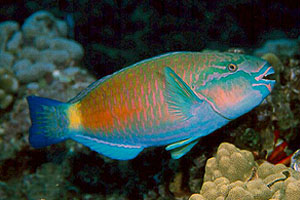DavidPT40
Contributor
I read an interesting article that talked about Nassau groupers eating too many parrotfish. The parrotfish are helping reefs recover from the 1998 El Nino damage by eating algae so new coral can grow. Special reserves have been set up so the parrotfish can escape being eaten by the groupers.
I'm skeptical about the special reserves. Where can a parrotfish go that a grouper can't?
Heres the article: http://www.sciencedaily.com/releases/2006/01/060106131757.htm
Just FYI, heres a parrotfish

and heres a grouper

I'm skeptical about the special reserves. Where can a parrotfish go that a grouper can't?
Heres the article: http://www.sciencedaily.com/releases/2006/01/060106131757.htm
Just FYI, heres a parrotfish

and heres a grouper




